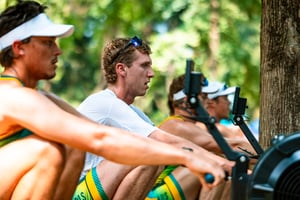
Strength and Conditioning
- Develop robust athletes and minimise any potential injuries.
- Improve the movement efficiency of the athlete’s rowing stroke.
- Develop underlying physical capacities (strength, power, strength endurance etc) and general athletic competencies (pelvic stability, scapular stability, thoracic mobility, squat pattern etc) that improve performance.
Good technical execution of an S & C program and appropriate exercise progression are essential so athletes do not injure themselves in the gym environment. Therefore rowing coaches are encouraged to use S & C coaches who have obtained the Australian Strength and Conditioning Association – Level 2 qualification, to assist in this area.
- Robustness and Injury Prevention
- Efficiency
- Athletic Development
- Useful Resources
Robustness and Injury Prevention
Improve the movement efficiency of the rowing stroke
Dry land training provides the opportunity to try to address technical deficiencies. For example – the ability to row long is primarily determined by hip mobility, hamstring length and thoracic mobility. The movement pattern of the rock over is determined by lumbo –pelvic rhythm and a good hip hinge pattern, connection & coordination of the kinetic chain at the catch, trunk stability (from scapular to the pelvis), postural deficiencies, speed of movement etc. All these technical aspects of the rowing stroke can be developed within an athlete’s S & C program.
Athletic Development
Useful Resources
There are a number of useful documents available to the rowing community with regards to sports medicine. Rowing Australia Medical Team have put together the below documentation for rowers and coaches which may assist in injury prevention and management.
- Mobilise Poster
- Activate Poster
- Pattern Poster
- Stretch Poster
- Combined Mobilise, Activate, Pattern and Strech Poster
- Core Essentials Poster
- Injury First Aid | Lower Back Pain
- Injury First Aid | Chest Wall Pain
.png)
.png?width=180&height=100&name=Untitled%20design%20(33).png)